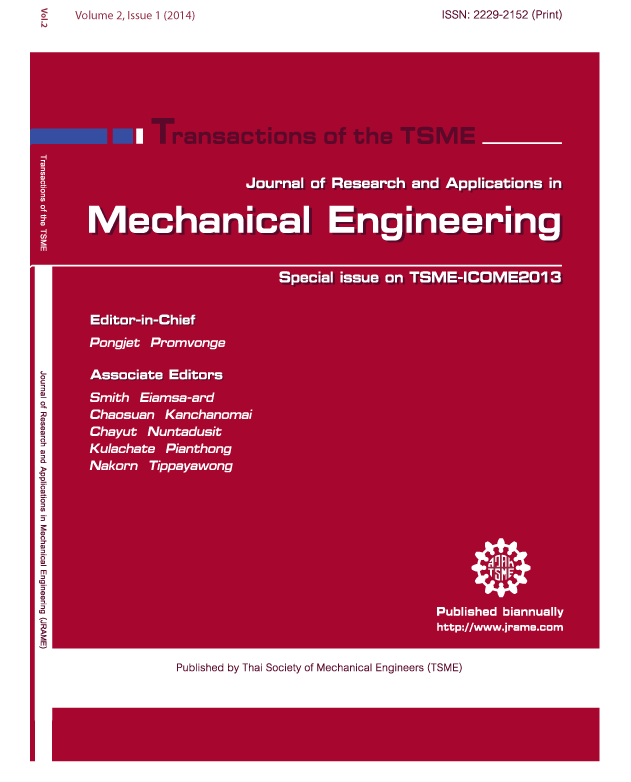The notch effect to strain distribution on Thai femoral bone after total knee arthroplasty
Main Article Content
Abstract
The strain distribution occurs on femoral bone while the loads transfer from proximal to distal part. The bone may be fracture after received more strain than 25,000 microstrain. Notching of the anterior femoral cortex after total knee arthroplasty can occur when making an anterior femoral bone cut. The notch of bone makes the stress concentration and transform to strain that should make the bone fracture. This study aims to vary the notch size with 3 depths as 1.5, 2.5 and 3.5 mm. and evaluate the strain distribution on the notch with finite element method under daily activities load to find the notch effect to strain distribution on Thai femoral bone. The result showed that the maximum strain occur 1,530 and 1,830 microstrain under walking and stair-climbing respectively. The rise of depth notch tend to increase the maximum strain on the femoral bone, which the surgeon will be avoid this condition for a good clinical result.
Article Details
This work is licensed under a Creative Commons Attribution-NonCommercial-ShareAlike 4.0 International License.
References
anterior femoral notching in total knee arthroplasty, Journal Bone and Joint Surgery, Vol. 82-A, 2000, pp.
1096-1101.
[2] Madsen, F., Kjaersgaard-Amderson, P., Juhl, M. and Sneppen, O. A custom-made prosthesis for the treatment
of supracondylar femoral fractures after knee arthroplasty: report of four cases, J. Orthop Trauma, Vol. 3,
1989, pp. 332-337.
[3] Dennis, D.A. Periprosthetic fractures following total knee arthroplasty, Journal Bone & Joint Surgery, Vol.
83-A, 2001, pp. 120-130.
[4] Peraz, A., Mahar, A., Negus, C., Newton, P. and Impelluso, T. A computational evaluation of the effect of
intramedullary nail material properties on the stabilization of simulated femoral shaft fracture, J Med
Eng&Phys, Vol. 30, 2008, pp. 755-760.
[5] Heller, M.O., Bergmann, G., Kassi, J.P., Claes, L., Hass, N.P. and Duda, G.N. Determination of muscle
loading at the hip joint for use in pre-clinical testing, Biomechanics, Vol. 38, 2005, pp. 1155-1163.
[6] Duda, G.N., Heller, M., Albinger, J., Schulz, O., Schneider, E. and Claes, L. Influence of muscle forces on
femoral strain distribution, Biomechanics, Vol. 31, 1998, pp. 841-846.
[7] Aaron, R.K. and Scott, R. Supracondylar fracture of the femur after total knee arthroplasty, Clin Orthop, Vol.
219, 1987, pp. 136-139.
[8] Lesh, M.L., Schneider, D.J., Deol, G., Davis, B., Jacobs, C.R. and Pellegrini, V.D. The consequences of
anterior femoral notching in total knee arthroplasty, J. Bone & Joint Surgery, Vol. 82-A, 2000, pp. 1096-1101.
[9] Frost, H.M. Defining osteopenias and osteoporoses: Another view (with insights from a new paradigm),
Bone, Vol. 20, 1997, pp. 385-391.



